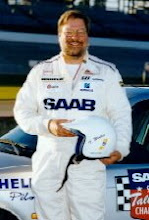After our DNS at Brainerd, Fart-hinder Racing (a.k.a. Vintage Ice And Gravel Rally Racing Association / VIAGRRA) was looking to get some track time to make up for it at the Road America "Drift Into Winter" ChumpCar race.
A test session at Brainerd six weeks prior had revealed a few areas that needed attention, most notably the brakes. It turns out that when the anti-lock brake system was neutered in the first racing season, it de-activated the ABS pump which acted as a power boost for the brakes. As a result, the pedal was very hard, and the rear brakes were not working at all. They had not worked since the Saab's first race in 2010! A few hours of study and it was determined that the ABS pump could be activated by re-connecting a few wires that had been clipped out. Sure enough it worked. A few other minor details were cleared up, and we even had time to add a front air dam. With two weeks before the race, the car was ready to go!
 The two-day, 16-hour race was primarily the Central Region Chumpionship, but there were only 27 cars entered for that, with teams from Minnesota to Texas participating. An additional 60 cars made the green flag on Saturday morning for a total of 87 cars on track. Fart-hinder Racing was grateful to be among them.
The two-day, 16-hour race was primarily the Central Region Chumpionship, but there were only 27 cars entered for that, with teams from Minnesota to Texas participating. An additional 60 cars made the green flag on Saturday morning for a total of 87 cars on track. Fart-hinder Racing was grateful to be among them.In addition to the usual drivers -- Mark Fitzpatrick, Mike Mandy, Travis McCormick and car owner Tim Winker -- John Stiller from Detroit would join us again. Our primary goal for the weekend was to drive fast and spend as little time as possible in the pits. Finishing in the top half would be a bonus.
 |
 |
| Collapsed front suspension due to ball joint failure. |
Mark went back onto the track after nearly two hours, 40 laps behind the lead car. It wasn't long before he trusted the car enough to give it his full effort again. He came in at his specified time and turned the car over to Mike.
Mike had never driven the Road America course before, so spent the first few laps getting used to the course and the car. His stint behind the wheel was uneventful and he came in after a little over an hour.
John was up next and also had an uneventful ride, other than besting Tim's so-far quick lap. His time was 3:27.89, for an average of 70 mph.
 |
| Mark and Travis prepare to check under the hood, while Mike helps John get strapped into place. |
The team gave the car a once over, checking for loose nuts and bolts or anything that looked out of the ordinary. Mark reminded Travis to check the ball joint bolts that had been replaced. Good thing because they were quite loose, apparently had only been put on finger tight and not snugged down with a wrench. They were tightened properly before the car was lowered off the jack. Tires were swapped front to rear for the second day's action.
It should be mentioned that the weather was a little cooler than normal for late October, and there was frost on the cars when we got up on Sunday morning. There was a bit of fog in the air as the cars took to the track but it quickly burned off into a lovely autumn day, though it remained cool.
 |
| Mike heads into turn 1 on the first lap. |
By the time Tim got aboard for the final hour and a half, it was starting to rain. After a few laps the rain came down harder and several cars spun on the wet surface. A full course yellow was declared so safety crews could retrieve the broken and damaged cars. More than a few had gone off and impacted a barrier, and would not make it back to the race. Tim spun once in turn 12, and got quite loose in 14, prompting him to pull into the pits to see if maybe a rear tire had gone flat. All tires looked good, so it was back on track. Lap times were much slower due to the rain, but Tim was passing cars that had drivers apparently being extra cautious to finish the final hour.
The checkered flag was dropped at the appointed time and it was over. Another BMW had won overall, and the first place trophy in the non-Chumpionship category went to a BMW from Duluth. The Fart-hinder Saab was unofficially classified in 44th place overall.
We toasted the weekend with a selection of beer from Lake Superior Brewing Company, who had kindly provided us with a couple of cases of their product.
Our primary goal had been achieved. We finished with little difficulty and every driver got a load of track time. The car came home with no body damage, only a crinkled front spoiler from the ball joint incident. We finished ahead of the BMWs Tubby Butterman, British-American Racing, Cheap Shot and several other top teams that did not make it to the finish. Smiles all around.
Thanks to our sponsors: eEuroparts.com, Hanover European Parts, Lake Superior Brewing Company and Airport Signs and Graphics.
 |
| Tim, John, Travis, Mike, Mark, and a rather twisted air dam. |

















